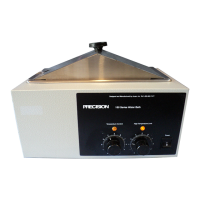6
6. MAINTENANCE
WARNING:
UNIT MUST BE DISCONNECTED FROM POWER
SOURCE PRIOR TO SERVICING. IT IS
RECOMMENDED THAT ALL SERVICE BE
PERFORMED BY QUALIFIED SERVICE
PERSONNEL.
CAUTION:
ELECTROLYSIS CAN DAMAGE STAINLESS
STEEL. THIS CAN OCCUR IF AN OBJECT IS
ALLOWED TO REST DIRECTLY ON THE
SURFACE, TRAPPING MOISTURE THAT
BECOMES OXYGEN STARVED BUT IS
SURROUNDED BY WATER CONTAINING
OXYGEN. THE RESULTING ELECTROLYTIC
ACTION WILL PIT OR CORRODE THE
STAINLESS STEEL.
Background
Stainless steel is an alloy of steel with chromium
and nickel which increase the metal's resistance to
rust and corrosion. However, if not properly cared
for it can rust and corrode. Exposure to air provides
the passivations for clean stainless steel. This
exposure produces a thin, durable chromium-oxide
film that forms rapidly on the alloy surface and
gives stainless steel its characteristic "stainless"
quality. Exposure of the surface to water other
oxidizing environments also produces this
passivating film. However, if free oxygen is not
available due to scale or contamination buildup the
metal surface may become vulnerable to attack.
Maintaining a neutral pH and frequent cleaning
with detergent and water will give you years of
trouble free service for your water bath. The follow-
ing are some guidelines to keep in mind.
Water
Distilled water is recommended. Maintain pH
between 7 and 9 to minimize corrosion of the
stainless steel.
De-ionized or reverse-osmosis water may be used.
However, if this water is very pure it may be
corrosive to stainless steel; and in such cases
always add 20-40 ppm (20 to 40 mg/liter)
disodium phosphate or sodium bicarbonate.
Adjust dosage to give a pH of 7 to 9. See "pH
Control" below.
If the above water is not available you may use
clean, aerated soft tap water provided the total
solids concentration is <500 ppm.
pH Control
Be sure to check pH regularly. If pH is <6.0, add
disodium phosphate to increase pH to a 7 to 9
value. Sodium carbonate or sodium bicarbonate
may be used but tend to form scale which must be
rinsed out regularly. If pH is >10.0 add sodium
bisulfate to decrease pH to a 7 to 9 value. Avoid
adding harsh alkalines or acids since they may
cause localized corrosion and result in unstable pH.
Anti-Fungal -- Anti-Bacterial Additives
These additives are permissible to use as long as
the pH of the aqueous solution is kept within the
range of 7 to 9. Some of these are available
through your supply dealer. Be sure they are not
harmful to stainless steel.
Prevention of Scale Buildup
Additives commonly available for use in swimming
pools and spas may be acceptable in circulating
baths only. In static baths these are generally not
effective. This is why it is best to use distilled,
deionized or RO water treated as described in
"WATER" above. If scale buildup is detected
(especially around immersion heaters) clean the
bath and replace water as soon as practical.
Other Water Additives
Proper maintenance of the stainless steel bath
chamber will help assure many years of service.
It should be cleaned regularly with mild soapy
water and rinsed with distilled water.
IMPORTANT: If it is necessary to use the following
chemicals, limit the exposure time to a maximum of
four hours. Clean surfaces immediately after use
by rinsing with distilled water.
Aluminum Chloride Barium Chloride
Bichloride of Mercury Calcium Chloride
Carbolic Acid Chlorinated Lime
Citric Acid (boiling) Dakin's Solution
Ferrous Chloride Mercury Salts
Lysol Mercuric Chloride Phenol
Potassium Permanganate
Stannous Chloride
Sodium Hypochlorite Tartaric Acid
Potassium Thiocyanate Lysol

